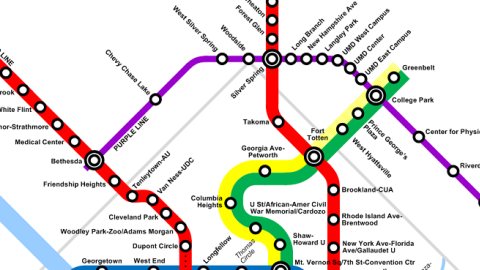Based on claims of an increase in ridership of less than one percent 25 years from now, the Maryland Transit Administration (MTA) proposes that Maryland move ahead with the Purple Line light rail, a $2.4 billion construction project. The proposed project makes no economic sense, and the cost to taxpayers is just plain wasteful.
For those unfamiliar with the project, the Maryland National Capital Purple Line would connect New Carrollton, Maryland with Bethesda, Maryland. The project would displace a popular multi-use path, local mom-and-pop retail shops and current land use. Environmentalists have sued to block the project as harmful to the environment and small creatures known as amphipods. In order to do this “good,” MTA will require over $1 billion in federal dollars with the rest coming from the state of Maryland and a new private partner just to build the project. Future Marylanders will foot the bill to pay for cost overruns and to subsidize the operation of the project.
MTA estimates that the Purple Line would lead to 11,800 new daily riders throughout the metropolitan area by the year 2040. Of course, 11,800 new riders sounds like a large number. But the MTA study notes that by 2040 the daily ridership on transit without the Purple Line would be 1.45 million. So, the 11,800 new riders for the Purple Line represent less than a one percent increase (0.8%) in the ridership baseline, less than the measurement error inherent in projecting 25 years into the future.
Moreover, MTA–as an advocate for the Purple Line–is not a disinterested party. Its projected numbers should be viewed as an upper bound on the likely increase in ridership. Further, their study was conducted using proprietary, subscription-based software that MTA has refused to share with the public. Because the study is inaccessible, the underlying assumptions that form the foundation of the research are also a mystery. Simply stated, MTA’s ridership results cannot be independently replicated. Its projections decades into the future are not reliable.
The costs associated with the proposed Purple Line are equally troubling. Over the past few years, MTA has released project updates, each projecting increased costs. Since project discussions began in earnest in 2001, the costs have more than doubled, even though the planners have “removed” major construction problems. Unfortunately, some of those “problems” were promises made to the community based on safety. The most recent projection, from July 2014, finds the project will cost more than $2.4 billion just in capital costs. That figure does not include the operational costs for the Purple Line. Nor does it include the value to local communities of lost trees, homes, neighborhoods, quiet bicycle paths, and shopping.
MTA’s 2014 cost projections will undoubtedly increase in coming years. Public transit projects rarely come in under budget.
Even accepting MTA’s upper bound projected ridership numbers and its understated capital cost projections, the resulting projected capital cost per rider does not pass any reasonable test for public investment. MTA finds that the 2014 capital costs are $205,760 per new 2040 rider for the Purple Line. This cost does not include operational and other costs associated with the project. Furthermore, it does not include the losses to local communities for disruptions. It is difficult to see that $205,760 for a seat on a trolley decades from now is a prudent use of anyone’s money, let alone scarce public funds.
Montgomery and Prince Georges Counties are two of the most affluent counties in America, but $205,760 is too expensive for these counties under any circumstances. In 2012, the latest data available, per capita income was $48,690 in Montgomery County and $32,254 in Prince Georges County, both well above the national average of $28,051. It would be difficult to explain to county residents why the state is investing the equivalent of four or six times the income for the average resident now so that one person may ride the Purple Line in a few decades. It would be even more difficult to explain to county residents why the state is making the same mistake not once, but 11,800 times.
Alternatively, Maryland could take the $2.4 billion and distribute it to each of its nearly 6 million residents. The result is more than $400 per person, or more than $1,600 for a family of four. Those Marylanders could take the money and spend it now, or invest it. At market interest rates, the value of those funds would be substantially greater by 2040.
In looking at public investment projects whose benefits will not be available for many years or decades, the proper way to value them is to consider over the life of the project the entire benefits of the proposed project as well as the entire costs. MTA has not presented such calculations for the Purple Line. The information that MTA has provided, however, clearly indicates that costs of the projects almost certainly exceed any potential benefits.
In recent years Maryland has raised taxes on its residents, so that the state is one of the highest-taxed jurisdictions in the country. Embarking on the $2.4 billion Purple Line will pave the way for additional tax increases, further eroding Maryland’s financial ranking, for a project that will serve less than one percent of daily ridership 25 years from its start date. Surely Maryland residents deserve better.



















